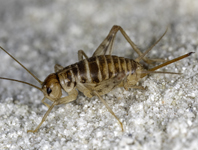Abstract
The genus Oreobates Jiménez de la Espada (1872) is monophyletic, and currently 24 species of Oreobates have been named (Köhler & Padial, 2016). Oreobates distributed from southern Colombia to central Brazil and northwestern Argentina (Köhler & Padial, 2016; Teixeira, Amaro, Recoder, De Sena, & Rodrigues, 2012). Most species of Oreobates occur in the cloud and montane forests of the tropical and subtropical Andes from Ecuador to Argentina (Padial et al., 2012). Padial et al., (2012) described Oreobates amarakaeri with two specimens collected in 2008 between 685–1000 m a.s.l. in Distrito Camanti, Quispicanchis Province, Department of Cusco, Peru (Figure 1). Herein we report four additional specimens of O. amarakaeri, extending its distributional and altitudinal ranges in southern Peru. We collected specimens during our surveys in the Departments of Cusco and Puno.
References
Boulenger, G.A. (1902) Descriptions of new batrachians and reptiles from the Andes of Peru and Bolivia. Annals and Magazine of Natural History, Series 7, 10 (59), 394–402.
https://doi.org/10.1080/00222930208678691
Catenazzi, A., Lehr, E., Rodriguez, L.O. & Vredenburg, V.T. (2011) Batrachochytrium dendrobatidis y el Colapso de la Riqueza de Especies y Abundancia de Anuros en el Parque Nacional del Manu, Sureste de Perú. Conservation Biology, 25 (2), 382–391.
https://doi.org/10.1111/j.1523-1739.2010.01604.x
Catenazzi, A. & Rodríguez, L. (2001) Diversidad, distribución y abundancia de anuros en la parte alta de la Reserva de Biosfera del Manu. Manu y Otras Experiencias de Investigación y Manejo de Bosques Neotropicales, 2001, 1–308.
Köhler, J. & Padial, J.M. (2016) Description and Phylogenetic Position of a New (Singleton) Species of Oreobates JiméNez De La Espada , 1872 (Anura: Craugastoridae) from the Yungas of Cochabamba, Bolivia. Annals of Carnegie Museum, 84 (1), 23–38.
https://doi.org/10.2992/007.084.0104
Padial, J.M., Chaparro, J.C., Castroviejo-Fisher, S., Guayasamin, J.M., Lehr, E., Delgado, A.J. & De la Riva, I. (2012) A revision of species diversity in the Neotropical genus Oreobates (Anura: Strabomantidae), with the description of three new species from the Amazon slopes of the andes. American Museum Novitates, 3752, 1–55.
https://doi.org/10.1206/3752.2
Teixeira Junior, M., Amaro, R.C., Recoder, R.S., De Sena, M.A. & Rodrigues, M.T. (2012) A relict new species of Oreobates (Anura, Strabomantidae) from the Seasonally Dry Tropical Forests of Minas Gerais, Brazil, and its implication to the biogeography of the genus and that of South American Dry Forests. Zootaxa, 1982, 37–52.
Villacampa, J., Serrano-Rojas, S. & Whitworth, A. (2016) Amphibians of the Manu Learnig Center and others areas of the Manu Region. The Cress Foundation, Cusco, 283 pp. Available from: https://view.joomag.com/field-guide-amphibians-of-manu/0741739001481300238?short (accessed 11 December 2018)

